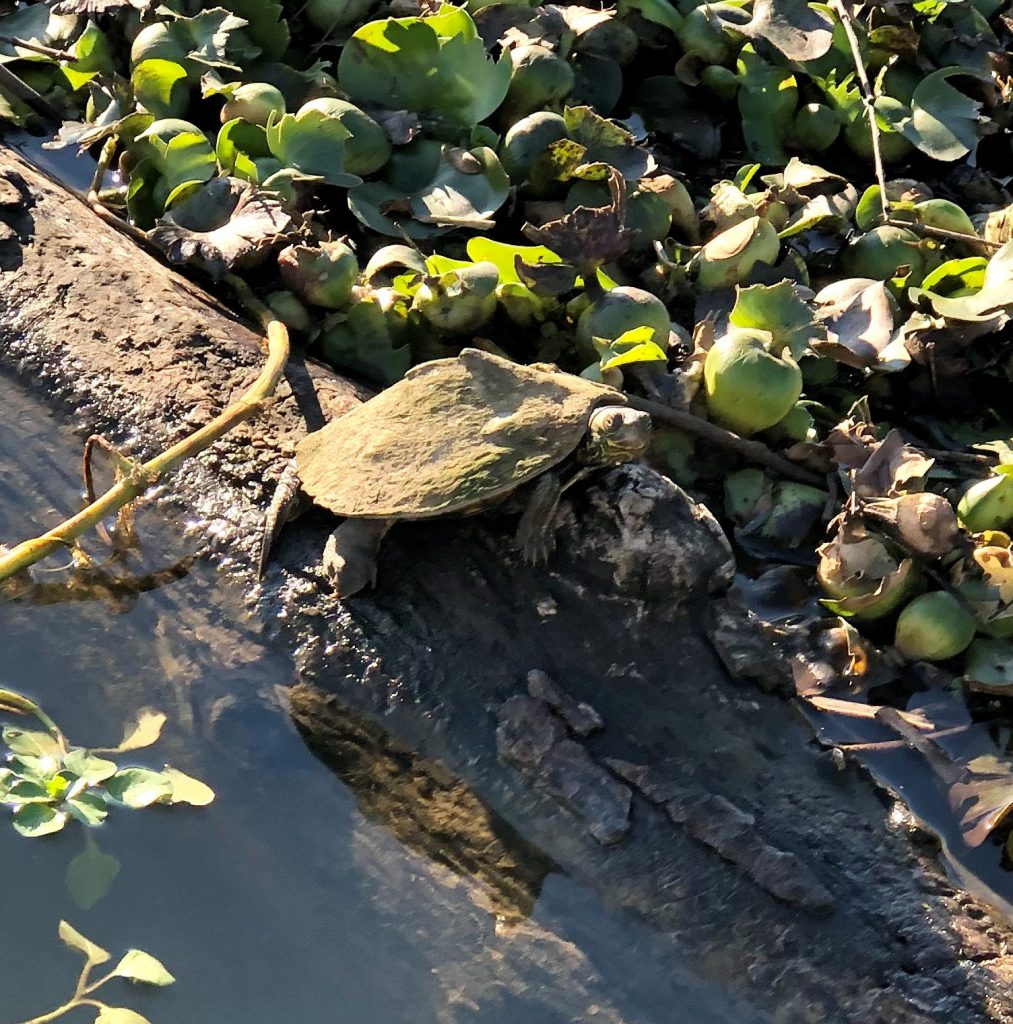Florida has a great variety of turtles. Actually, the species richness here is higher than any other state – though Alabama may argue. Many are familiar to us. If we have not seen them, we have at least heard of them. But that may not be the case with map turtles.
Map turtles are in the same family as many of the common ponds turtles but are in the genus Graptemys. The patterns on their shells and skin are beautiful and they have raised scutes along the midline of their shells giving them a “sawback” or “dinosaur” look. They are associated with alluvial rivers due to their diet of shellfish, which cannot be found in the low pH waters of tannic rivers. To our west, in Alabama and Mississippi, there are several species of them. And as you move up into the Mississippi valley and into the Midwest, there are even more. But here in Florida there are only two. Let’s meet them.
The Barbour’s Map Turtle (Graptemys barbouri) is associated with the Apalachicola River system. First discovered in the Chipola River, it has now been found in the Chattahoochee, Flint, and Apalachicola River systems, as well as the Choctawhatchee and Pea Rivers. It may have been introduced to the Ochlockonee and Wacissa.

Female map turtles are much larger than the males, and the female Barbour’s Map is the largest of all map turtles – with a carapace length of 33cm (13 in.). She has a very broad head (8cm, 3in. wide) to crush the shells of her favorite prey – snails. The males only reach 13cm (5in.) carapace length and their heads are much narrower. Barbour’s Maps prefer flowing rivers with limestone outcrops. These outcrops support the snails they like to eat. That said, they have been found in high numbers within the silty channels of these rivers.
Females take many years to mature, possibly as long as 14. Males mature in 3-4 years. Breeding begins in the spring and nesting begins in late April but will continue into August. Like most turtles, they seek out sandy beaches where they will lay multiple clutches of 7-10 eggs over the span of the nesting season.
Fallen trees (snags) are important basking areas and map turtles use them frequently. During the cooler months, and low water periods along the river, they will hide in deep pockets within the limestone rock. Their home range along the rivers are between 250 and 1500 meters (74 and 441 feet), with males having a larger range. Other than nesting, activity on land is not common.
Their populations seem to be stable, though they are protected by FWC and possession without a permit is illegal. Harvest does still happen, and the activity known as “plinking” (shooting them off their basking logs) occurs as well. Nest depredation, and the killing of adults, by raccoons is common. Crows are another threat.
The Escambia Map Turtle (Graptemys ernsti) is associated with the Escambia River. With the Florida section of this river only being 54 miles long, it has the most restricted range of any turtle in the state. That said, along these stretches of river, it is one of the more abundant turtles. Paddling a lower section of the Escambia I counted an average of 11 individuals per basking log. It has been found in the Yellow and Shoal Rivers as well. But due to the lower pH and lack of mollusks, they are not found in the nearby Blackwater and Perdido Rivers.

Like all map turtles, it has beautiful markings on the shell and head. Like all map turtles, it has the characteristic “sawback” appearance down the middle of the carapace. Like all map turtles, the females are much larger than the males. However, the female of this species is not as large as the female Barbour’s Map – with a carapace length of 28cm (11in.).
The males of this species feed on a variety of insects but the females stay with the characteristic molluscan diet. The introduced Asiatic clam (Corbicula fluminea) is a particular favorite. Breeding occurs in the spring and nesting area are sandbars found along the river’s edge. These turtles are having problems with ATVs using such nesting areas, the removal of snag basking trees, and plinking. There are also concerns with the building of dams along the Alabama portion of the river. They are protected by FWC, and you cannot possess them without a permit.
With only two species of map turtles in the entire state, and both only found in the panhandle, these are unique species to the rich variety of turtles found here.
- Tips for Bear Encounters this Fall - November 10, 2025
- Pensacola Bay Invasive Species Summer Survey 2025 - November 3, 2025
- Our Environment: Part 24 – Our Changing Climate - November 3, 2025
